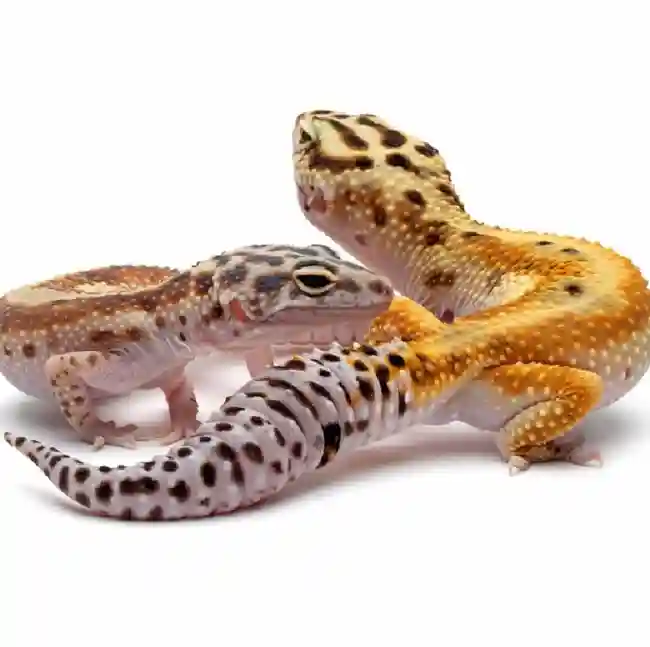
Leopard Gecko Care Sheet Leopard geckos (Eublepharis macularius) are among the most popular pet reptiles due to their docile nature, manageable size, and ease of care. Native to the arid and semi-arid regions of Afghanistan, Pakistan, and India, they thrive in warm, dry environments. With the right setup and routine, leopard geckos can live up to 15–20 years in captivity. Housing & Enclosure: A single adult leopard gecko requires at least a 20-gallon long tank, though larger enclosures are always better. Floor space is more important than height since they are ground-dwelling. A secure screen lid ensures proper ventilation and prevents escapes. Include hiding spots on both the warm and cool sides of the tank, as well as a moist hide filled with damp sphagnum moss or paper towels to help with shedding. Heating & Lighting: Leopard geckos are ectothermic and rely on external heat to regulate their body temperature. Use an under-tank heater (UTH) or heat mat on one side of the enclosure to create a temperature gradient. The warm side should reach 88–92°F (31–33°C), while the cool side can be around 75–80°F (24–27°C). A thermostat should always be used with heating devices to prevent overheating. UVB lighting isn’t strictly necessary but can be beneficial in small amounts (2–5% UVB) to aid in calcium absorption. Substrate: Avoid loose substrates like sand or gravel, which can cause impaction if ingested. Safer options include reptile carpet, tile, paper towels, or non-adhesive shelf liner. Clean the enclosure regularly, spot-cleaning daily and deep cleaning monthly. Diet & Feeding: Leopard geckos are insectivores. A diet of gut-loaded crickets, dubia roaches, and mealworms works well. Offer appropriately sized insects 2–3 times a week for adults and every other day for juveniles. Dust food with calcium powder at every feeding and a multivitamin supplement once or twice a week. Fresh, clean water should always be available in a shallow dish. Handling & Temperament: Leopard geckos are generally calm and tolerant of handling. Begin with short sessions, allowing the gecko to climb onto your hand. Always support their body and avoid grabbing their tail, as they may drop it as a defense mechanism. With regular, gentle interaction, they can become quite tame. Health & Shedding: Healthy leopard geckos have bright eyes, a plump tail, and smooth skin. They shed regularly—every 4–6 weeks for adults and more often for juveniles. Ensure humidity is adequate in the moist hide to assist with proper shedding. Watch for signs of illness like lethargy, weight loss, retained shed, or lack of appetite. A reptile vet should be consulted if issues arise. Enrichment & Behavior: Though not as interactive as mammals, leopard geckos enjoy exploring their environment. Adding safe decorations like caves, branches, or artificial plants provides mental stimulation. They are nocturnal, so expect most activity at night. With proper care, leopard geckos make rewarding and relatively low-maintenance pets suitable for beginners and experienced reptile keepers alike.
Leopard geckos (Eublepharis macularius) are among the most popular pet reptiles due to their docile nature, manageable size, and ease of care. Native to the arid and semi-arid regions of Afghanistan, Pakistan, and India, they thrive in warm, dry environments. With the right setup and routine, leopard geckos can live up to 15–20 years in captivity. Housing & Enclosure: A single adult leopard gecko requires at least a 20-gallon long tank, though larger enclosures are always better. Floor space is more important than height since they are ground-dwelling. A secure screen lid ensures proper ventilation and prevents escapes. Include hiding spots on both the warm and cool sides of the tank, as well as a moist hide filled with damp sphagnum moss or paper towels to help with shedding. Heating & Lighting: Leopard geckos are ectothermic and rely on external heat to regulate their body temperature. Use an under-tank heater (UTH) or heat mat on one side of the enclosure to create a temperature gradient. The warm side should reach 88–92°F (31–33°C), while the cool side can be around 75–80°F (24–27°C). A thermostat should always be used with heating devices to prevent overheating. UVB lighting isn’t strictly necessary but can be beneficial in small amounts (2–5% UVB) to aid in calcium absorption. Substrate: Avoid loose substrates like sand or gravel, which can cause impaction if ingested. Safer options include reptile carpet, tile, paper towels, or non-adhesive shelf liner. Clean the enclosure regularly, spot-cleaning daily and deep cleaning monthly. Diet & Feeding: Leopard geckos are insectivores. A diet of gut-loaded crickets, dubia roaches, and mealworms works well. Offer appropriately sized insects 2–3 times a week for adults and every other day for juveniles. Dust food with calcium powder at every feeding and a multivitamin supplement once or twice a week. Fresh, clean water should always be available in a shallow dish. Handling & Temperament: Leopard geckos are generally calm and tolerant of handling. Begin with short sessions, allowing the gecko to climb onto your hand. Always support their body and avoid grabbing their tail, as they may drop it as a defense mechanism. With regular, gentle interaction, they can become quite tame. Health & Shedding: Healthy leopard geckos have bright eyes, a plump tail, and smooth skin. They shed regularly—every 4–6 weeks for adults and more often for juveniles. Ensure humidity is adequate in the moist hide to assist with proper shedding. Watch for signs of illness like lethargy, weight loss, retained shed, or lack of appetite. A reptile vet should be consulted if issues arise. Enrichment & Behavior: Though not as interactive as mammals, leopard geckos enjoy exploring their environment. Adding safe decorations like caves, branches, or artificial plants provides mental stimulation. They are nocturnal, so expect most activity at night. With proper care, leopard geckos make rewarding and relatively low-maintenance pets suitable for beginners and experienced reptile keepers alike.